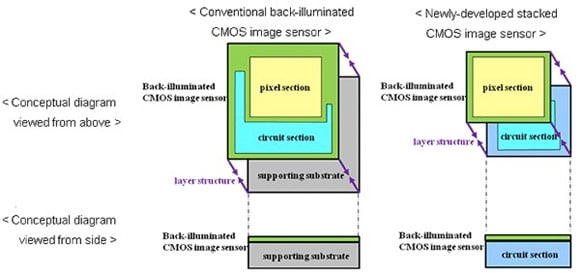Sony Bringing New Back-Illuminated 8MP CMOS Sensor To Cameraphones
Sony may be most likely to be associated with their VAIO notebooks and slimmer-than-slim HDTVs, but the company's camera modules are pretty stellar. The NEX line of mirrorless cameras are giving everyone else in that market a run for their money, and now the company is unveiling a next-gen back-illuminated CMOS image sensor that's more capable of capturing more precise imagery in the same size form factor as before. This image sensor layers the pixel section containing formations of back-illuminated structure pixels onto chips containing the circuit section for signal processing, which is in place of supporting substrates for conventional back-illuminated CMOS image sensors. This structure achieves further enhancement in image quality, superior functionalities and a more compact size that will lead to enhanced camera evolution.
Conventional CMOS image sensors mount the pixel section and analog logic circuit on top of the same chip, which require numerous constraints when wishing to mount the large-scale circuits such as measures to counter the circuit scale and chip size, measures to suppress noise caused by the layout of the pixel and circuit sections, and optimizing the characteristics of pixels and circuit transistors.

Sony has succeeded in establishing a structure that layers the pixel section containing formations of back-illuminated structure pixels over the chip affixed with mounted circuits for signal processing, which is in place of supporting substrates used for conventional back-illuminated CMOS image sensors. By this stacked structure, large-scale circuits can now be mounted keeping small chip size. Furthermore, as the pixel section and circuit section are formed as independent chips, a manufacturing process can be adopted, enabling the pixel section to be specialized for higher image quality while the circuit section can be specialized for higher functionality, thus simultaneously achieving higher image quality, superior functionality and a more compact size. In addition, faster signal processing and lower power consumption can also be achieved through the use of leading process for the chip containing the circuits.
It's likely that the new sensor will begin to pop up in products without the Sony label on it, as well as with. With an 8MP version shipping to cameraphone makers in a few months, there's also a chance that many phones launched at MWC will pack Sony power on the imaging front. A new stack of Android phones to give the iPhone 4S camera some competition? Yeah, we'll take that.
Conventional CMOS image sensors mount the pixel section and analog logic circuit on top of the same chip, which require numerous constraints when wishing to mount the large-scale circuits such as measures to counter the circuit scale and chip size, measures to suppress noise caused by the layout of the pixel and circuit sections, and optimizing the characteristics of pixels and circuit transistors.

Sony has succeeded in establishing a structure that layers the pixel section containing formations of back-illuminated structure pixels over the chip affixed with mounted circuits for signal processing, which is in place of supporting substrates used for conventional back-illuminated CMOS image sensors. By this stacked structure, large-scale circuits can now be mounted keeping small chip size. Furthermore, as the pixel section and circuit section are formed as independent chips, a manufacturing process can be adopted, enabling the pixel section to be specialized for higher image quality while the circuit section can be specialized for higher functionality, thus simultaneously achieving higher image quality, superior functionality and a more compact size. In addition, faster signal processing and lower power consumption can also be achieved through the use of leading process for the chip containing the circuits.
It's likely that the new sensor will begin to pop up in products without the Sony label on it, as well as with. With an 8MP version shipping to cameraphone makers in a few months, there's also a chance that many phones launched at MWC will pack Sony power on the imaging front. A new stack of Android phones to give the iPhone 4S camera some competition? Yeah, we'll take that.

